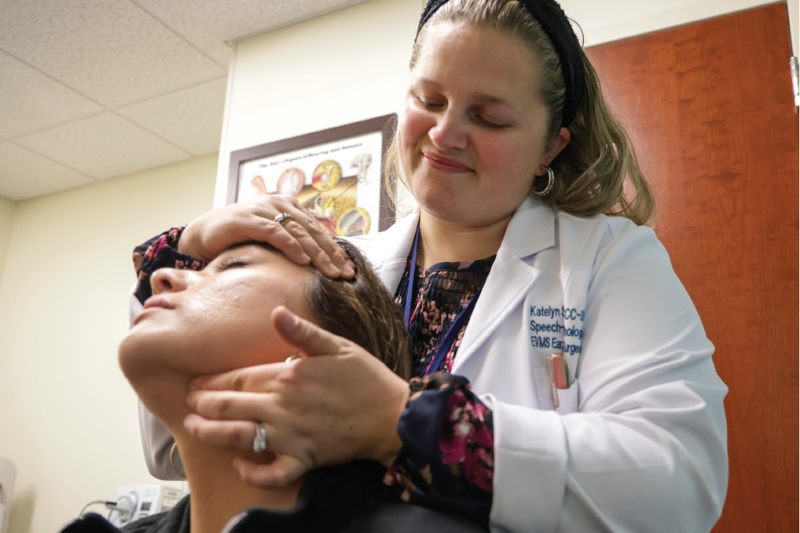Finding her voice — again: A tale of passion and rehabilitation
Ever since Katelyn Swiader watched “The Little Mermaid” at 8 years old, she has been captivated with the voice.
“I wanted to sing like Ariel when I grew up,” says Swiader, who is now a Speech Pathologist and Professional Voice Specialist at EVMS. “No one in my house knew how to sing, and there was no musical talent, but I was adamant.”
A classmate gave her the phone number of a voice coach, and she begged her mom for lessons. These lessons and her love for song eventually led to the Governor’s School for the Arts in Norfolk. When she was cast as the lead in the opera “Amahl and the Night Visitors,” she felt a new energy.
“The night the lights went up, I was hooked on singing on stage.”
Just before an opening night performance with the Virginia Opera in her junior year of high school, Swiader’s voice unexpectedly began to fade. She was seen at EVMS Laryngology, where they used a long flexible camera and strobe light to perform a stroboscopic exam on her vocal folds.
“That was the first time I ever got to see my voice on video," Swiader says. “I just fell in love. I was always curious how I was able to get my voice to do certain things. When I heard people sing, I could feel where their tension was or what they needed to work on. It felt like a secret special power.”
Swiader and her doctors managed the issue with her voice, and she returned to the stage. But the experience sparked an interest, and she began to investigate the science of voice.
“Do I want to go to school to be an opera singer? Do I want to go to school to be an ear, nose and throat doctor? I compared the trajectory of how to become either.”
Ultimately, Swiader pursued a degree in vocal performance at George Mason University on a path to become a professional opera singer. She traveled the world singing and training in opera, but the mechanics of the voice continued to fascinate her.
Then, her voice failed her again.
“Extreme stress, certain medications, not taking good care of myself and having to use my voice all the time,” she says, “I would have zero voice by the end of the day.”
Her teacher suggested that she visit a general ear, nose and throat doctor.
“My voice did get better, but I should have gone straight to a laryngologist,” Swiader says. “They extensively understand the mechanics of the voice in motion. None of the teachers I had since Governor’s School ever said the word laryngologist or speech therapist in my entire career of music.”
Swiader continued to master roles on stage and managed other artists at an opera company. But after witnessing the lifestyle of a professional opera singer, she decided it may not align with her future goals. She accepted a job at the Governor’s School teaching musical theater and classical voice opera. She also started a business in private instruction, which is where she learned more about speech therapy.
After shadowing a speech therapist, Swiader realized the profound effect that voice therapy could have on the quality of people’s lives.
“There was someone my age, in her young twenties, who was using a computer device to speak,” she recalls. “People could be in car accidents and have their voices taken from them. I knew I wanted to help them regain their voices.”
Swiader continued teaching at the Governor’s School but felt pulled back to speech therapy. She enrolled in several science classes at Old Dominion University. This helped earn her a spot in their speech-language pathology graduate program, where she learned resonant voice therapy and worked with the transgender population. She also gained experience with cochlear implants and hearing aids.
Today, Swiader is certified in speech-language pathology, owns Sound Waves Voice & Communication and works closely with the team at the EVMS Voice and Swallowing Center as its first speech therapist in over a decade. Patients are evaluated by Benjamin Rubinstein, MD, Assistant Professor of Otolaryngology, or John Sinacori, MD, Associate Professor of Otolaryngology, and often begin sessions with her at the same visit.

“Sometimes I see patients all day in one-on-one therapy,” Swiader says. “We may do aerodynamic measures, behavioral assessments, measure the voice with a spectrogram or vocal exercises. We work on techniques like laryngeal massage manipulation, relaxing tension and airflow and resonance.”
EVMS Laryngology providers often assist performers at Virginia Musical Theater by conducting collaborative voice evaluations.
For Swiader, the serendipitous turn from professional singing to speech-language pathology led her on the greater path to mentoring students and helping to rehabilitate voices at EVMS.
“My voice has always been such a huge part of everything I do,” she shares. “Our voices are much more than moving people on stage. I don’t want to just help people make pretty sounds — but to live their lives by getting their voices back.”

/prod01/channel_41/media/evms_public/departments/otolaryngology/head__neck_cancer_center/swiader1-800X533.png)